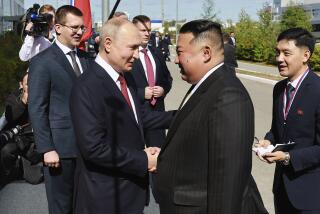A Good Week’s Work
- Share via
This week’s Washington summit meeting may not have been the “clear success” that President Reagan described, but it was a triumph of reason, no matter how ill-defined.
A sharp bargainer with an eye on the bottom line would say that the parting words of Reagan and Soviet General Secretary Mikhail S. Gorbachev soared higher than their achievements.
But the lack of precision in the communique on their three-day summit is part of the beauty of the document. What they could not settle they post-poned. For the first time in recent arms-control history they avoided a pretense at precision that would only open up new issues to bicker about later on. There was no grim shrug of frustration like the one that Gorbachev gave at the end of their Reykjavik meeting that lingers as the sharpest memory of a failed summit.
They will meet again in Moscow sometime before June, after negotiators in Geneva tackle instructions from the top on deep cuts in long-range nuclear missiles and nuclear defense systems, notably “Star Wars.” In general, the orders are to start identifying specific missiles that should be scrapped as part of the next arms-control treaty on the agenda, one that would cut in half the forces of long-range nuclear missiles in both countries.
They agreed that the emphasis should be on so-called heavy missiles, the ones that U.S. strategists have worried for years could clean out America’s long-range weapons in one blow. Score one for the Americans. The Soviets are concerned about the threat from unlimited numbers of sea-launched cruise missiles, and, for the first time, Washington agreed to discuss putting a ceiling on those weapons. Score one for the Soviets.
The Soviets have insisted that reductions of missiles must go hand in hand with an agreement that would put strict limits on the testing and development of Star Wars, the President’s plan for a space-based defense against nuclear attack.
In a debate, America would win points on the way the question of Star Wars testing and development was settled. The language of the agreement seems to leave the United States a free hand. As a practical matter, the Senate already has told the office of the Strategic Defense Initiative not to do any testing that would violate the anti-ballistic-missile treaty, strictly interpreted.
Even without the Senate limitation, the Soviets have little to fear from Star Wars, which is behind schedule and is now being forced by the Pentagon to meet rigid milestones of performance to qualify for the funds that Congress has appropriated.
There will be legitimate complaints that arms control stole the summit show at the expense of human rights and regional conflicts like Afghanistan and Nicaragua that could be powder kegs in East-West relations. How to reduce Soviet tanks and troops on the Continent so that they do not seem eternally poised for an attack to the English Channel was discussed, but not resolved. Human rights warranted a single inconclusive sentence in the post-summit communique, leaving no clue as to whether Gorbachev flew home still convinced that U.S. pressures to gain freedom for Soviet Jews and what Soviet physicist Andrei D. Sakharov calls “prisoners of conscience” are part of a plot to engineer a brain drain from the Soviet Union.
Still, the summit meeting did produce one signed treaty that will start drawing down the number of nuclear weapons in Europe. It was, after all, nuclear arms and the threat of annihilation they pose to both nations that brought Reagan and Gorbachev together in the first place. They will meet again in Moscow next spring whether or not there is clear progress on further arms control. They can try again on the issues that they did not resolve in Washington this week. By the standards of U.S.-Soviet summitry over a quarter-century, it was a good and hopeful week’s work despite an often indistinct bottom line.
More to Read
Sign up for Essential California
The most important California stories and recommendations in your inbox every morning.
You may occasionally receive promotional content from the Los Angeles Times.












